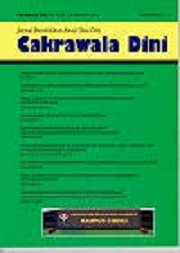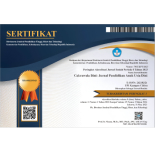Imperative of Viable Learning Environment for Early Childhood Education: A Literature Review
Abstract
Keywords
Full Text:
PDFReferences
Adams, E. K., Nathan, A., Trost, S. G., Schipperijn, J., Shilton, T., Trapp, G., Maitland, C., Thornton, A., Mclaughlin, M., George, P., Wenden, E., and Christian, H. (2023). Play Active physical activity policy intervention and implementation support in early childhood education and care: Results from a pragmatic cluster randomised trial. International Journal of Behavioral Nutrition and Physical Activity, 20(46), 1-17. https://doi.org/10.1186/s12966-023-01442-0
Adjei-Boadi, D., Agyei-Mensah, S., Adamkiewicz, G., Rodriguez, J. I., Gemmell, E., Ezzati, M., Baumgartner, J., and Owusu, G. (2022). Neighbourhood, built environment and children’s outdoor play spaces in urban Ghana: Review of policies and challenges. Landscape and Urban Planning, 218, 104288. https://doi.org/10.1016/j.landurbplan.2021.104288
Aina, A. Y., and Bipath, K. (2022). Availability and use of infrastructural resources in promoting quality early childhood care and education in registered early childhood development centres. South African Journal of Childhood Education, 12(1), 980. https://doi.org/10.4102/sajce.v12i1.980
Aldridge, J. M., and Bianchet, S. (2022). Using student feedback about the learning environment as a starting point for co-construction. Learning Environments Research, 25, 939-955. https://doi.org/10.1007/s10984-021-09403-9
Aldridge, J. M., Rijken, P. E., and Fraser, B. J. (2021). Improving learning environments through whole-school collaborative action research. Learning Environments Research, 24, 183-205. https://doi.org/10.1007/s10984-020-09318-x
Ali, E., Constantino, K. M., Hussain, A., and Akhtar, Z. (2018). The effects of play-based learning on early childhood education and development. Journal of Evolution of Medical and Dental Sciences, 7(43), 6808-6811. https://doi.org/10.14260/jemds/2018/0000
Amissah-Essel, S., Hagan Jr, J. E., and Schack, T. (2020). Assessing the quality of physical environments of early childhood schools within the Cape Coast metropolis in Ghana using a sequential explanatory mixed-methods design. European Journal of Investigation in Health, Psychology and Education, 10(4), 1158-1175. https://doi.org/10.3390/ejihpe10040081
Aneke, J. C., and Akpusugh, R. A. (2022). Influence of learning environment on the academic performance of secondary school students in Makurdi Metropolis. ScienceOpen Preprints, 1-13. 10.14293/S2199-1006.1.SOR-.PPFNKIF.v1
Ardoin, N. M., and Bowers, A. W. (2020). Early childhood environmental education: A systematic review of the research literature. Educational Research Review, 31, 100353. https://doi.org/10.1016/j.edurev.2020.100353
Barblett, L., Knaus, M., and Barratt-Pugh, C. (2016). The pushes and pulls of pedagogy in the early years: Competing knowledges and the erosion of play-based learning. Australasian Journal of Early Childhood, 41(4), 36-43. https://doi.org/10.1177/183693911604100405
Bartie, M., Dunnell, A., Kaplan, J., Oosthuizen, D., Smit, D., Dyk, A. V., Cloete, D. R., and Duvenage, M. (2016). The play experiences of preschool children from a low‐socio‐economic rural community in Worcester, South Africa. Occupational Therapy International, 23(2), 91-102. https://doi.org/10.1002/oti.1404
Becker, C., Lauterbach, G., Spengler, S., Dettweiler, U., and Mess, F. (2017). Effects of regular classes in outdoor education settings: A systematic review on students’ learning, social and health dimensions. International Journal of Environmental Research and Public Health, 14(5), 485. https://doi.org/10.3390/ijerph14050485
Bodrova, E., Leong, D. J., and Yudina, E. (2023). Play is a play, is a play, is a play… or is it? Challenges in designing, implementing and evaluating play-based interventions. Frontiers in Psychology, 14, 1034633. https://doi.org/10.3389/fpsyg.2023.1034633
Caceres, S., Tanner, J., and Williams, S. (2016). Maximizing child development: Three principles for policy-makers. Journal of Human Development and Capabilities, 17(4), 583-589. https://doi.org/10.1080/19452829.2016.1243521
Cho, H. J., Levesque-Bristol, C., and Yough, M. (2023). How autonomy-supportive learning environments promote Asian international students’ academic adjustment: A self-determination theory perspective. Learning Environments Research, 26, 51-76. https://doi.org/10.1007/s10984-021-09401-x
Cohrssen, C., Church, A., and Tayler, C. (2016). Play-based mathematics activities as a resource for changing educator attitudes and practice. SAGE Open, 6(2), 1-14. https://doi.org/10.1177/2158244016649010
Cooper, A. (2015). Nature and the outdoor learning environment: The forgotten resource in early childhood education. International Journal of Early Childhood Environmental Education, 3(1), 85-97. https://eric.ed.gov/?id=EJ1108430
Cumming, T., Wong, S., and Logan, H. (2021). Early childhood educators’ well-being, work environments and ‘quality’: Possibilities for changing policy and practice. Australasian Journal of Early Childhood, 46(1), 50-65. https://doi.org/10.1177/1836939120979064
Damşa, C. I., and Ludvigsen, S. (2016). Learning through interaction and co-construction of knowledge objects in teacher education. Learning, Culture and Social Interaction, 11, 1-18. https://doi.org/10.1016/j.lcsi.2016.03.001
Derman, M. T., Zeteroğlu, E. S., and Birgül, A. E. (2020). The effect of play-based math activities on different areas of development in children 48 to 60 months of age. SAGE Open, 10(2), 1-12. https://doi.org/10.1177/2158244020919531
Essa, S. G., Celik, T., and Human-Hendricks, N. E. (2023). Personalized adaptive learning technologies based on machine learning techniques to identify learning styles: A systematic literature review. IEEE Access, 11, 48392-48409. https://doi.org/10.1109/ACCESS.2023.3276439
Frimpong, S. O. (2019). The classroom physical environment as a “Third Teacher” for an early childhood education provision in the Ga-West Municipality of Ghana. PEOPLE: International Journal of Social Sciences, 4(3), 1339-1360. https://dx.doi.org/10.20319/pijss.2019.43.13391360
Ghanbari-Azarneir, S., Anbari, S., Hosseini, S. B., and Yazdanfar, S. A. (2015). Identification of child-friendly environments in poor neighborhoods. Procedia-Social and Behavioral Sciences, 201, 19-29. https://doi.org/10.1016/j.sbspro.2015.08.114
Glassner, A. (2022). Training youth at risk mentors in Paths, an innovative TE program: Promoting resilience, mental wellbeing and meaningful learning through a self-determined learning environment. Learning Environments Research, 25, 841-857. https://doi.org/10.1007/s10984-021-09391-w
Grieshaber, S., Krieg, S., McArdle, F., and Sumsion, J. (2021). Intentional teaching in early childhood education: A scoping review. Review of Education, 9(3), e3309. https://doi.org/10.1002/rev3.3309
Hamilton, D., McKechnie, J., Edgerton, E., and Wilson, C. (2021). Immersive virtual reality as a pedagogical tool in education: A systematic literature review of quantitative learning outcomes and experimental design. Journal of Computers in Education, 8, 1-32. https://doi.org/10.1007/s40692-020-00169-2
Harris, F. (2018). Outdoor learning spaces: The case of forest school. Area, 50(2), 222-231. https://doi.org/10.1111/area.12360
Hasibuan, R., and Fitriani, L. (2023). Innovative approach to reading skill development: Jigsaw strategy and crossword puzzle media. Journal of Arabic Language Learning and Teaching, 1(2), 61-74. https://doi.org/10.23971/jallt.v1i2.98
Haslip, M. J., and Gullo, D. F. (2018). The changing landscape of early childhood education: Implications for policy and practice. Early Childhood Education Journal, 46, 249-264. https://doi.org/10.1007/s10643-017-0865-7
Healey, A., Mendelsohn, A., Council on Early Childhood, Sells, J. M., Donoghue, E., Earls, M., Hashikawa, A., McFadden, T., Peacock, G., Scholer, S., Takagishi, J., Vanderbilt, D., and Williams, P. G. (2019). Selecting appropriate toys for young children in the digital era. Pediatrics, 143(1), e20183348. https://doi.org/10.1542/peds.2018-3348
Hedefalk, M., Almqvist, J., and Östman, L. (2015). Education for sustainable development in early childhood education: A review of the research literature. Environmental Education Research, 21(7), 975-990. https://doi.org/10.1080/13504622.2014.971716
Hillesøy, S. (2016). The contribution of support teachers in facilitating children’s peer interactions. International journal of early childhood, 48, 95-109. https://doi.org/10.1007/s13158-016-0157-1
İnan, H. Z. (2021). Understanding the Reggio Emilia-inspired literacy education: A meta-ethnographic study: Reggio Emilia-inspired literacy education. International Journal of Curriculum and Instruction, 13(1), 68-92. https://www.ijci.net/index.php/IJCI/article/view/574
Kessel, J. (2018). Let our children play: The importance of play in early childhood education. University of Montana Journal of Early Childhood Scholarship and Innovative Practice, 2(1), 1-6. https://scholarworks.umt.edu/ecsip/vol2/iss1/5
Maifala, S. (2024). Creating a conducive teaching and learning climate at a rural school in South Africa: The management team's role. Issues in Educational Research, 34(3), 1089-1105. https://search.informit.org/doi/10.3316/informit.T2024121700011401592905658
Manassakis, E. S. (2020). Children’s participation in the organisation of a kindergarten classroom. Journal of Early Childhood Research, 18(1), 18-28. https://doi.org/10.1177/1476718X19882714
Matafwali, B., and Mofu, M. (2023). Exploring the feasibility of outdoor indigenous games and songs to enhance play-based pedagogy in early childhood education. Journal of Childhood, Education & Society, 4(3), 391–405. https://doi.org/10.37291/2717638X.202343270
Mead, L. (2017). Importance of play-based learning in early childhood: Birth to eight years. The Challenge of Teaching, 115-121. https://doi.org/10.1007/978-981-10-2571-6_16
Meng, S. (2023). Enhancing teaching and learning: Aligning instructional practices with education quality standards. Research and Advances in Education, 2(7), 17-31. https://www.paradigmpress.org/rae/article/view/703
Merrienboer, J. J. G. V., McKenney, S., Cullinan, D., and Heuer, J. (2017). Aligning pedagogy with physical learning spaces. European Journal of Education, 52(3), 253-267. https://doi.org/10.1111/ejed.12225
Modise, M. R. (2021). Exploring early childhood centre managers’ perceptions of their roles in promoting developmentally-appropriate physical environments in South Africa. Journal for the Education of Gifted Young Scientists, 9(4), 339-350. https://doi.org/10.17478/jegys.1010694
Nel, A., Joubert, I., and Hartell, C. (2017). Teachers’ perceptions on the design and use of an outdoor learning environment for sensory and motor stimulation. South African Journal of Childhood Education, 7(1), 1-11. https://hdl.handle.net/10520/EJC-ac5588983
Ogunyemi, F. T., and Ragpot, L. (2015). Work and play in early childhood education: Views from Nigeria and South Africa. South African Journal of Childhood Education, 5(3), 1-7. https://doi.org/10.4102/sajce.v5i3.344
Oliveras-Ortiz, Y., Bouillion, D. E., and Asbury, L. (2021). Learning spaces matter: Student engagement in new learning environments. Journal of Education, 201(3), 174-182. https://doi.org/10.1177/0022057420908062
Papadakis, S., and Kalogiannakis, M. (2017). Mobile educational applications for children: What educators and parents need to know. International Journal of Mobile Learning and Organisation, 11(3), 256-277. https://doi.org/10.1504/IJMLO.2017.085338
Phajane, M. H. (2019). Play and teaching in early childhood classrooms: Perspectives and practices of teachers and children in South Africa. e-BANGI Journal, 16(4), 1-14. https://openurl.ebsco.com/EPDB%3Agcd%3A2%3A12599810/detailv2?sid=ebsco%3Aplink%3Ascholar&id=ebsco%3Agcd%3A137064113&crl=c&link_origin=scholar.google.co.id
Raikes, A., Koziol, N., Davis, D., and Burton, A. (2020). Measuring quality of preprimary education in sub-Saharan Africa: Evaluation of the measuring early learning environments scale. Early Childhood Research Quarterly, 53, 571-585. https://doi.org/10.1016/j.ecresq.2020.06.001
Reynolds, A. J., Ou, S. R., Mondi, C. F., and Hayakawa, M. (2017). Processes of early childhood interventions to adult well‐being. Child Development, 88(2), 378-387. https://doi.org/10.1111/cdev.12733
Richter, L. M., Daelmans, B., Lombardi, J., Heymann, J., Boo, F. L., Behrman, J. R., Lu, C., Lucas, J. E., Perez-Escamilla, R., Dua, T., Bhutta, Z. A., Bhutta, Z. A., Stenberg, K., Gertler, P., and Darmstadt, G. L. (2017). Investing in the foundation of sustainable development: Pathways to scale up for early childhood development. The Lancet, 389(10064), 103-118. https://www.thelancet.com/journals/lancet/article/PIIS0140-6736(16)31698-1/abstract
Richter, L. M., Tomlinson, M., Watt, K., Hunt, X., and Lindland, E. H. (2019). Early means early: Understanding popular understandings of early childhood development in South Africa. Early Years, 39(3), 295-309. https://doi.org/10.1080/09575146.2019.1613346
Savva, A., and Erakleous, V. (2018). Play-based art activities in early years: Teachers’ thinking and practice. International Journal of Early Years Education, 26(1), 56-74. https://doi.org/10.1080/09669760.2017.1372272
Schenke, K., Ruzek, E., Lam, A. C., Karabenick, S. A., and Eccles, J. S. (2018). To the means and beyond: Understanding variation in students’ perceptions of teacher emotional support. Learning and instruction, 55, 13-21. https://doi.org/10.1016/j.learninstruc.2018.02.003
Schweig, J. D. (2016). Moving beyond means: Revealing features of the learning environment by investigating the consensus among student ratings. Learning Environments Research, 19, 441-462. https://doi.org/10.1007/s10984-016-9216-7
Seden, K., Wangmo, S., Dorji, K., and Wangmo, W. (2020). Impact of classroom wellbeing on student learning: Bhutanese students' perceptions. Journal of the International Society for Teacher Education, 24(2), 30-44. https://eric.ed.gov/?id=EJ1304484
Sethusha, M. J. (2020). Creating play-based opportunities to learn: Exploring how early childhood teachers use space for teaching and learning. The International Journal of Early Childhood Learning, 27(1), 45-58. https://doi.org/10.18848/2327-7939/CGP/v27i01/45-58
Shaari, M. F., and Ahmad, S. S. (2016). Physical learning environment: Impact on children school readiness in Malaysian preschools. Procedia-Social and Behavioral Sciences, 222, 9-18. https://doi.org/10.1016/j.sbspro.2016.05.164
Snyder, H. (2019). Literature review as a research methodology: An overview and guidelines. Journal of Business Research, 104, 333-339. https://doi.org/10.1016/j.jbusres.2019.07.039
Sparaci, L., and Gallagher, S. (2025). A Kaleidoscope of play: A new approach to play analysis in childhood. Philosophical Psychology, 38(2), 718-747. https://doi.org/10.1080/09515089.2023.2234938
Spence, C. (2020). Senses of place: Architectural design for the multisensory mind. Cognitive Research: Principles and Implications, 5(46), 1-26. https://doi.org/10.1186/s41235-020-00243-4
Sumiya, M., and Nonaka, T. (2021). Does the spatial layout of a playground affect the play activities in young children? A pilot study. Frontiers in Psychology, 12, 627052. https://doi.org/10.3389/fpsyg.2021.627052
Syomwene, A. (2017). Teacher support and school environment factors influencing children's outdoor play in early childhood curriculum in pre-schools in Kenya. Journal of Scientific Research and Reports, 14(4), 1-13. https://doi.org/10.9734/JSRR/2017/33594
Tatham-Fashanu, C. (2023). A third space pedagogy: Embracing complexity in a super-diverse, early childhood education setting. Pedagogy, Culture & Society, 31(4), 863-881. https://doi.org/10.1080/14681366.2021.1952295
Tomaz, S. A., Jones, R. A., Hinkley, T., Twine, R., Kahn, K., Norris, S. A., and Elizabeth, C. (2019). Physical activity in early childhood education and care settings in a low-income, rural South African community: An observational study. Rural and Remote Health, 19(4), 1-10. https://search.informit.org/doi/10.3316/informit.139206946896464
Van der Westhuizen, L. M., and Hannaway, D. M. (2021). Digital play for language development in the early grades. South African Journal of Childhood Education, 11(1), 1-8. https://doi.org/10.4102/sajce.v11i1.925
Wu, B., and Goff, W. (2023). Learning intentions: A missing link to intentional teaching? Towards an integrated pedagogical framework. Early Years, 43(2), 411-425. https://doi.org/10.1080/09575146.2021.1965099
Yeh, Y. C., Hsieh, M. H., Yang, Z. S., Chang, M. M., Chien, H. J., Hong, W. L., and Tsai, H. H. (2024). Facilities and equipment in childcare settings: Promoting a sustainable environment for infants and toddlers. Problems of Education in the 21st Century, 82(6A), 995-1008. https://www.ceeol.com/search/article-detail?id=1299073
DOI: https://doi.org/10.17509/cd.v16i2.86327
Refbacks
- There are currently no refbacks.
Copyright (c) 2025 UPI Kampus Cibiru

This work is licensed under a Creative Commons Attribution-ShareAlike 4.0 International License.
Cakrawala Dini: Jurnal Pendidikan Anak Usia Dini
Published in collaboration Program Studi PGPAUD UPI Kampus Cibiru, APG PAUD Indonesia, and PPJ PAUD Indonesia

Cakrawala Dini: Jurnal Pendidikan Anak Usia Dini is licensed under a Creative Commons Attribution-ShareAlike 4.0 International License.
Based on a work at https://ejournal.upi.edu/index.php/cakrawaladini.















